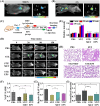Tandem reaction-powered near-infrared fluorescent molecular reporter for real-time imaging of lung diseases
- PMID: 40308959
- PMCID: PMC12038431
- DOI: 10.1039/d5sc01488c
Tandem reaction-powered near-infrared fluorescent molecular reporter for real-time imaging of lung diseases
Abstract
Diabetes and its complications have drawn growing research attention due to their detrimental effects on human health. Although optical probes have been used to help understand many aspects of diabetes, the lung diseases caused by diabetes remain unclear and have rarely been explored. Herein, a tandem-reaction (TR) strategy is proposed based on the adjacent diol esterification-crosslinking reaction and the nicotinamide reduction reaction of nicotinamide adenine dinucleotide (NADH) to design a lung-targeting near-infrared (NIR) small molecule probe (NBON) for accurate imaging of diabetic lung diseases. NBON was designed by coupling a phenylboronic acid analog that can form borate ester bonds by reversibly binding with NADH via an esterification-crosslinking reaction. Streptozotocin (STZ)-induced diabetic mice and metformin (MET)/epalrestat (EPS)-repaired model studies demonstrated that NBON allowed the sensitive imaging of NADH for lung disease diagnosis and therapeutic monitoring. The proposed antioxidant mechanism by which EPS alleviates diabetic lung disease was studied for the first time in living cells and in vivo. Furthermore, NBON was successfully applied in the detection of NADH in tumors and lung metastases. Overall, this work provides a general platform for a NIR NADH probe design, and advances the development of NADH probes for mechanistic studies in lung diseases.
This journal is © The Royal Society of Chemistry.
Conflict of interest statement
There are no conflicts to declare.
Figures







Similar articles
-
De Novo Design of Near-Infrared Fluorescent Agents Activated by Peroxynitrite and Glutathione-Responsive Imaging for Diabetic Liver Disease.Adv Healthc Mater. 2024 Jan;13(2):e2302466. doi: 10.1002/adhm.202302466. Epub 2023 Nov 7. Adv Healthc Mater. 2024. PMID: 37840532
-
The recent development of fluorescent probes for the detection of NADH and NADPH in living cells and in vivo.Spectrochim Acta A Mol Biomol Spectrosc. 2021 Jan 15;245:118919. doi: 10.1016/j.saa.2020.118919. Epub 2020 Sep 6. Spectrochim Acta A Mol Biomol Spectrosc. 2021. PMID: 32977107 Review.
-
Boronic Acid: A Bio-Inspired Strategy To Increase the Sensitivity and Selectivity of Fluorescent NADH Probe.J Am Chem Soc. 2016 Aug 24;138(33):10394-7. doi: 10.1021/jacs.6b05810. Epub 2016 Aug 11. J Am Chem Soc. 2016. PMID: 27500425
-
Rational Design of NIR-II G-Quadruplex Fluorescent Probes for Accurate In Vivo Tumor Metastasis Imaging.J Am Chem Soc. 2024 May 1;146(17):11669-11678. doi: 10.1021/jacs.3c13851. Epub 2024 Apr 22. J Am Chem Soc. 2024. PMID: 38644738
-
Progression in Near-Infrared Fluorescence Imaging Technology for Lung Cancer Management.Biosensors (Basel). 2024 Oct 14;14(10):501. doi: 10.3390/bios14100501. Biosensors (Basel). 2024. PMID: 39451714 Free PMC article. Review.
References
-
- Schuyler M. R. Niewoehner D. E. Inkley S. R. Kohn R. Am. Rev. Respir. Dis. 1976;113:37–41. - PubMed
LinkOut - more resources
Full Text Sources
Miscellaneous

